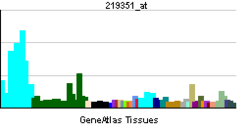TRAPPC2
Trafficking protein particle complex subunit 2 (TRAPPC2) also known as MBP-1-interacting protein 2A (MIP-2A) is a protein that in humans is encoded by the TRAPPC2 gene.[1][2] A processed pseudogene of this gene is located on chromosome 19, and other pseuodogenes of it are found on chromosome 8 and the Y chromosome. Two transcript variants encoding the same protein have been found for this gene.[2]
Function
Trafficking protein particle complex subunit 2 is thought to be part of a large multisubunit complex involved in the targeting and fusion of endoplasmic reticulum-to-Golgi transport vesicles with their acceptor compartment. In addition, the encoded protein can bind MBP1 and block its transcriptional repression capability.[2]
Genetic Location
The TRAPPC2 gene is located on the X-chromosome at position 22 between base-pairs 13,712,241 to 13,734,634.[3]
Clinical significance
Mutations in this gene are a cause of spondyloepiphyseal dysplasia tarda (SEDT).[2]
Interactions
TRAPPC2 has been shown to interact with Alpha-enolase[4] and CLIC1.[5]
References
- ↑ Gecz J, Shaw MA, Bellon JR, de Barros Lopes M (November 2003). "Human wild-type SEDL protein functionally complements yeast Trs20p but some naturally occurring SEDL mutants do not". Gene 320: 137–44. doi:10.1016/S0378-1119(03)00819-9. PMID 14597397.
- 1 2 3 4 "Entrez Gene: TRAPPC2 trafficking protein particle complex 2".
- ↑ "TRAPPC2 gene at Genetics Home Reference".
- ↑ Ghosh, A K; Majumder M; Steele R; White R A; Ray R B (January 2001). "A novel 16-kilodalton cellular protein physically interacts with and antagonizes the functional activity of c-myc promoter-binding protein 1". Mol. Cell. Biol. (UNITED STATES) 21 (2): 655–62. doi:10.1128/MCB.21.2.655-662.2001. ISSN 0270-7306. PMC 86643. PMID 11134351.
- ↑ Fan, Libin; Yu Wei; Zhu Xueliang (April 2003). "Interaction of Sedlin with chloride intracellular channel proteins". FEBS Lett. (Netherlands) 540 (1–3): 77–80. doi:10.1016/S0014-5793(03)00228-X. ISSN 0014-5793. PMID 12681486.
Further reading
- Shaw MA, Brunetti-Pierri N, Kádasi L, et al. (2004). "Identification of three novel SEDL mutations, including mutation in the rare, non-canonical splice site of exon 4". Clin. Genet. 64 (3): 235–42. doi:10.1034/j.1399-0004.2003.00132.x. PMID 12919139.
- Adams MD, Soares MB, Kerlavage AR, et al. (1993). "Rapid cDNA sequencing (expressed sequence tags) from a directionally cloned human infant brain cDNA library". Nat. Genet. 4 (4): 373–80. doi:10.1038/ng0893-373. PMID 8401585.
- Bernard LE, Chitayat D, Weksberg R, et al. (1996). "Linkage analysis of two Canadian families segregating for X linked spondyloepiphyseal dysplasia". J. Med. Genet. 33 (5): 432–4. doi:10.1136/jmg.33.5.432. PMC 1050619. PMID 8733060.
- Bonaldo MF, Lennon G, Soares MB (1997). "Normalization and subtraction: two approaches to facilitate gene discovery". Genome Res. 6 (9): 791–806. doi:10.1101/gr.6.9.791. PMID 8889548.
- Gedeon AK, Colley A, Jamieson R, et al. (1999). "Identification of the gene (SEDL) causing X-linked spondyloepiphyseal dysplasia tarda". Nat. Genet. 22 (4): 400–4. doi:10.1038/11976. PMID 10431248.
- Gécz J, Hillman MA, Gedeon AK, et al. (2001). "Gene structure and expression study of the SEDL gene for spondyloepiphyseal dysplasia tarda". Genomics 69 (2): 242–51. doi:10.1006/geno.2000.6326. PMID 11031107.
- Ghosh AK, Majumder M, Steele R, et al. (2001). "A novel 16-kilodalton cellular protein physically interacts with and antagonizes the functional activity of c-myc promoter-binding protein 1". Mol. Cell. Biol. 21 (2): 655–62. doi:10.1128/MCB.21.2.655-662.2001. PMC 86643. PMID 11134351.
- Gedeon AK, Tiller GE, Le Merrer M, et al. (2001). "The molecular basis of X-linked spondyloepiphyseal dysplasia tarda". Am. J. Hum. Genet. 68 (6): 1386–97. doi:10.1086/320592. PMC 1226125. PMID 11349230.
- Grunebaum E, Arpaia E, MacKenzie JJ, et al. (2001). "A missense mutation in the SEDL gene results in delayed onset of X linked spondyloepiphyseal dysplasia in a large pedigree". J. Med. Genet. 38 (6): 409–11. doi:10.1136/jmg.38.6.409. PMC 1734897. PMID 11424925.
- Mumm S, Zhang X, Vacca M, et al. (2001). "The sedlin gene for spondyloepiphyseal dysplasia tarda escapes X-inactivation and contains a non-canonical splice site". Gene 273 (2): 285–93. doi:10.1016/S0378-1119(01)00571-6. PMID 11595175.
- Gavin AC, Bösche M, Krause R, et al. (2002). "Functional organization of the yeast proteome by systematic analysis of protein complexes". Nature 415 (6868): 141–7. doi:10.1038/415141a. PMID 11805826.
- Takahashi T, Takahashi I, Tsuchida S, et al. (2003). "An SEDL gene mutation in a Japanese kindred of X-linked spondyloepiphyseal dysplasia tarda". Clin. Genet. 61 (4): 319–20. doi:10.1034/j.1399-0004.2002.610416.x. PMID 12030902.
- Fiedler J, Bittner M, Puhl W, Brenner RE (2003). "Mutations in the X-linked spondyloepiphyseal dysplasia tarda (SEDL) coding sequence are not a common cause of early primary osteoarthritis in men". Clin. Genet. 62 (1): 94–5. doi:10.1034/j.1399-0004.2002.620114.x. PMID 12123495.
- Strausberg RL, Feingold EA, Grouse LH, et al. (2003). "Generation and initial analysis of more than 15,000 full-length human and mouse cDNA sequences". Proc. Natl. Acad. Sci. U.S.A. 99 (26): 16899–903. doi:10.1073/pnas.242603899. PMC 139241. PMID 12477932.
- Gao C, Luo Q, Wang HL, et al. (2003). "[Identification of a novel mutation IVS2-2A-->C of SEDL gene in a Chinese family with X-linked spondyloepiphyseal dysplasia tarda]". Zhonghua Yi Xue Yi Chuan Xue Za Zhi 20 (1): 15–8. PMID 12579492.
- Xiao C, Zhang S, Wang J, et al. (2003). "A single nucleotide deletion of 293delT in SEDL gene causing spondyloepiphyseal dysplasia tarda in a four-generation Chinese family". Mutat. Res. 525 (1–2): 61–5. doi:10.1016/s0027-5107(02)00315-9. PMID 12650905.
- Fan L, Yu W, Zhu X (2003). "Interaction of Sedlin with chloride intracellular channel proteins". FEBS Lett. 540 (1–3): 77–80. doi:10.1016/S0014-5793(03)00228-X. PMID 12681486.
- Savarirayan R, Thompson E, Gécz J (2004). "Spondyloepiphyseal dysplasia tarda (SEDL, MIM #313400)". Eur. J. Hum. Genet. 11 (9): 639–42. doi:10.1038/sj.ejhg.5201025. PMID 12939648.
External links
- GeneReviews/NIH/NCBI/UW entry on X-Linked Spondyloepiphyseal Dysplasia Tarda
- OMIM entries on X-Linked Spondyloepiphyseal Dysplasia Tarda
| |||||||||||




